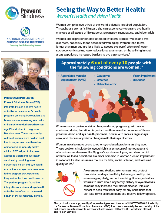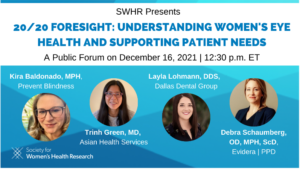Join a powerful, unprecedented alliance for better eye health for all.
Join IAPB-
Choose an alternate language here
According to the “The Future of Vision: Forecasting the Prevalence and Costs of Vision Problems” from Prevent Blindness, in the United States, women make up approximately 63% of persons who are blind and 62% of persons who are visually impaired. This mirrors trends seen globally, in which women make up two-thirds of individuals with vision loss. Throughout a woman’s lifespan, she can experience vision and eye health changes at all stages of life–puberty, pregnancy, menopause, and older adult. Women are disproportionately affected by nearly all major vision and eye disorders, especially those associated with aging. Women have higher rates of cataract, age-related macular degeneration, glaucoma, thyroid eye disease, dry eye, and refractive error.
In addition, women are less likely to receive treatment. According to a recent report, “The Lancet Global Health Commission on Global Eye Health: vision beyond 2020,” the gender imbalance can be attributed to demographic factors (women living longer than men) and social factors (women having reduced access to care). Women of lower socioeconomic status, lower educational attainment, or those living in rural areas experience increased barriers to eye care services. Coupled with the fact that more women serve in the lead caregiver role for their families, access to timely and quality eyecare services becomes even more difficult to obtain.
In 1908, Prevent Blindness was founded as public health advocacy organization, with the mission to end needless vision loss. Through a variety of ways, including:


Additionally, Prevent Blindness recently collaborated with the Society for Women’s Health Research (SWHR), and other
Prevent Blindness also collaborated with the National Association of Chronic Disease Directors on an issue brief series titled “Seeing the Way to Better Health.” One of the featured topics in this series is Women’s Health and Vision Health. The goal of the issue brief is to provide ways for public health programs to integrate vision health education, early detection strategies, and vision loss support into their existing programmatic structures. The issue brief features a state-level example of support for women’s vision health, data and surveillance information, and a variety of toolkits and resources to support program efforts. Other topics covered in the issue brief series includes Diabetes and Vision Health and Cognitive Health and Vision health.
When it comes to public and patient education, nothing is more powerful than stories from individuals with a lived experience. As a part of Prevent Blindness’s recognition of April as Women’s Eye Health Month, we launched a new video featuring three women and their experiences with vision loss and how to manage impacts to mental health. The video- titled “Diabetes, Vision Loss, and Mental Wellness,” was developed with support from Regeneron, and educates the viewer about resilience, finding a community, and the range of programs and resources that are available to help an individual experiencing vision loss.
Prevent Blindness’s network of affiliates provide on-the-ground programs to improve the health of vision in women throughout the United States. These efforts include informational seminars, participation in health fairs for women, providing certified vision screenings to help detect vision issues, and coordinating access to free eye care services for women who are unable to afford the care on their own.
As an example of community-level efforts, Prevent Blindness Texas integrated vision and eye health activities into a women’s health program providing free cervical and breast cancer screening events for uninsured or underinsured women age 21 and older in the greater Houston area. This approach considered the health needs of the whole individual in an accessible and supportive setting.
At Prevent Blindness, our goal is to work with patient advocates, legislators, eyecare professionals, partner groups, allied personnel, and the public to provide services which eliminate preventable vision loss. We know that it takes engagement of all stakeholders to be active participants if we are to reduce disparities in women’s eye health in the United States. and around the world. Member organizations of the IAPB can serve as convener, advocate, and moderator for stakeholder groups to become engaged in vision- but certainly the key voices at the table should be those of women themselves. We must first listen to their needs and then, together, seek solutions for increased access to quality eyecare and improved vision and eye health that are patient-centered and equitable.
Focus on Gender Equity, throughout the year, shares knowledge, inspiration and ideas from some of the world’s most innovative experts and inserts eye health and Gender Equality onto the agenda of the world’s most pressing development issues and is supported by Santen.
Image on top: Prevent Blindness North Carolina provides free retinal screenings to residents across the state, including Michelle